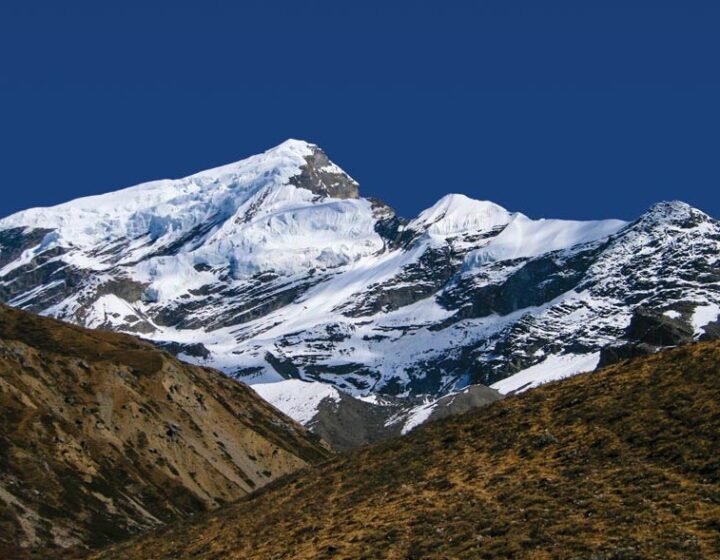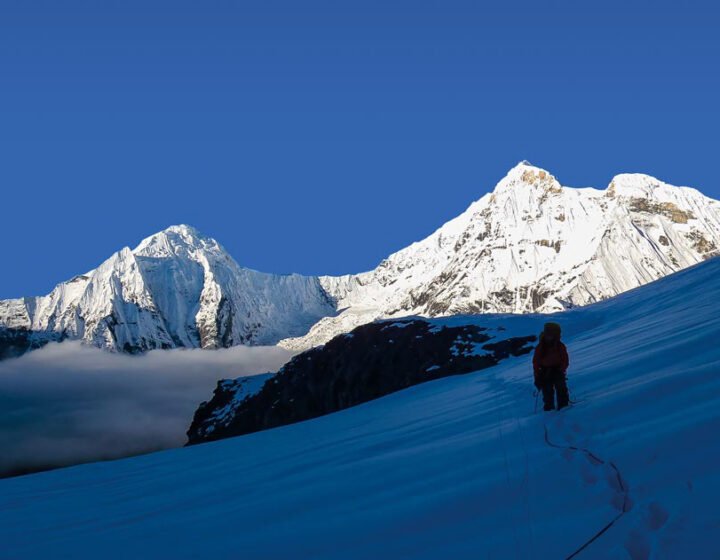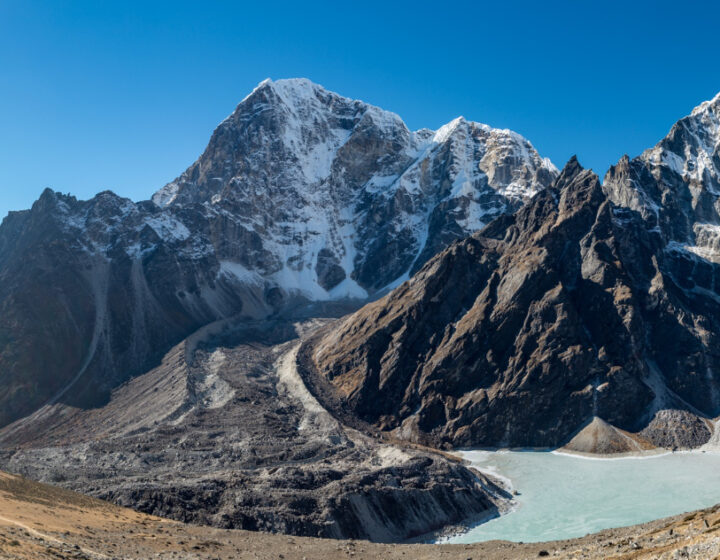- Details
Detailed itinerary
Itinerary- Tour Includes/Excludes
- Useful Info
- Trip Map
- FAQ
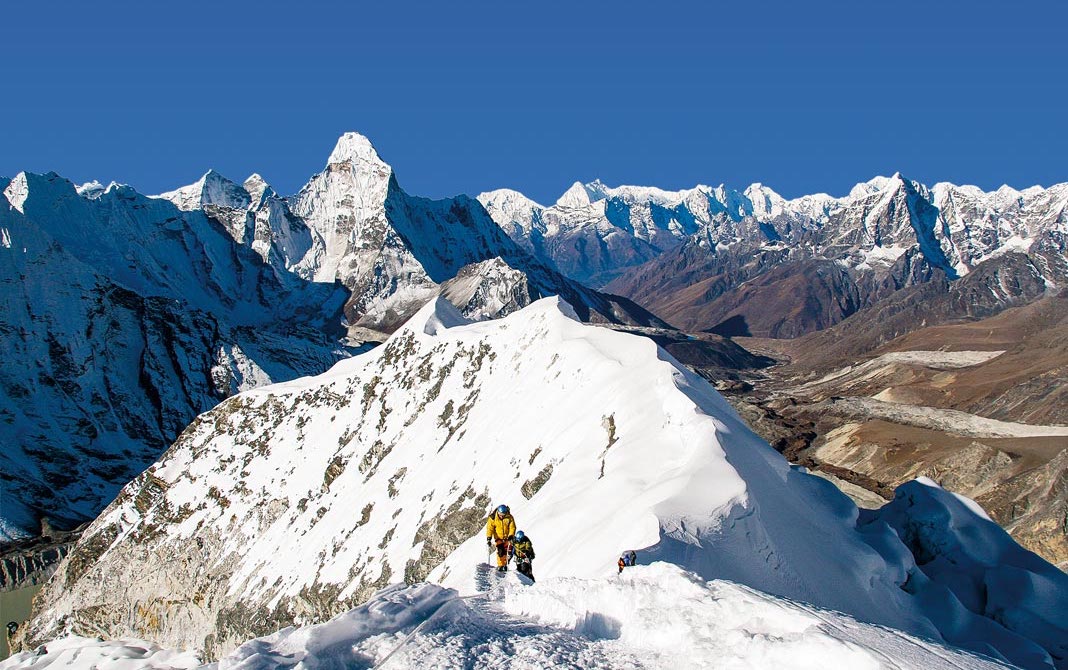
Trip overview
The abundance of peaks in Nepal has been a record-breaker for the world. Among the 1,310 peaks in Nepal, only 238 are open for climbing, whose heights are more than 8000 m. It is no surprise that more than 700,000 tourists come to Nepal each year just for climbing. Tourists traveling to peaks have increased by 50 to 60 percent since the 1990s, according to data.The peaks of Nepal have incredibly great potential for adventure.
Island peak climbing is an amazing adventure for all climbers, and the most thrilling thing is that it lies on the lap of Everest Base Camp, which is a fantastic destination for many trekkers in the world. This region is home to a number of ethnic groups, including Sherpa, Bhotiya, Tamang, and others. Tibetan Buddhism is the most widely practiced religion in the region. As a result, various Buddhist landmarks, including monasteries, gompas, chortens, prayer wheels, prayer flags, and others, may be found when hiking.
Most travelers get confused with their backpacks when they think of long days of trekking. We also guide our travelers in these aspects. Besides that, we will design an appropriate travel package for Island Peak. On the very first day, we will allow our travelers to explore the beautiful city of Kathmandu and shop for other necessary things for themselves while climbing.
The next day, from Kathmandu, we will take a flight to Lukla. Regular EBC trails will take you from Lukla to Monjo and Jorsale. This route takes you to Phakding and Namche Bazaar. You will travel from Namche via breathtaking scenery to the towns of Tengboche and Pheriche. Trekkers will also cross through Sagarmatha National Park’s protected region. After that, you’ll go to Nagarjun before returning to Pheriche. Your next destination before reaching Everest Base Camp is Gorak Shep.
Before arriving at Island Peak Base, you have to travel to Dingboche and Chukkung first, and from Everest base camp you get the opportunity to climb the island peak. Those who are not able to climb a peak on a given day can take it as a buffer day. Weather-related delays and medical necessity aside, these buffering delays help to complete your journey at the scheduled time. There is only one way to return to Kathmandu, and that is through Lukla airport. This trek’s trail is incredibly fascinating, traveling through glaciers, rivers, waterfalls, and hills.
Highlights:
- Island Peak (also known as Imja Tse in the local language) is an excellent introduction to Himalayan mountain climbing.
- Spectacular views of Everest, Lhotse, Makalu, and many other 7,000 m+ peaks.
- Combinable with a classic journey, the Everest Base Camp trek
- Experience the culture of Himalayan Sherpas inside the Khumbu region.
- From the Island Peak top, enjoy breathtaking views of the snow-capped mountains, including Mt. Everest, Mt. Makalu, Mt. Ama Dablam, Mt. Cho Oyu, Mt. Lhotse, and many others.
Itinerary
Day 1: Arrival in KathmanduArrive in Kathmandu and transfer to your accommodation, where you can relax and recover from jet lag.
Information regarding the initial arrival. A Nepali ethnic cultural program will precede the welcome dinner.
A half-day trip of the world heritage monuments Pashupatinath and Boudhanath.
The trek leader will provide a trek briefing and trek pack distribution in the afternoon.
A picturesque mountain flight to Lukla in the morning takes 40 minutes.
Rearrange the hike Duffle bags before being loaded by porters for the simple afternoon walk to Phakding (2,650 m). Walk to Namche Bazaar (3,440 m), the Khumbu region's primary trading center. Cross the Dudhkoshi River suspension bridge five times.
We enter Everest National Park, where we get our first glimpse of Mt. Everest
Acclimatization day consists of a short trip to the Everest View Hotel or a nearby viewpoint, in accordance with the rule of altitude goes high, sleep low. In the afternoon, you can visit the museum, which displays the history and culture of the Everest region, as well as the flora and fauna.
The initial walking would be moderate through terraces and up to Mongla, then downward until crossing the river. We eventually come to a lovely settlement perched above the tree line.
We go through high grazing meadows above the river in the morning and halt for lunch at Pangboche. After lunch, continue up the glacial valley for the remainder of the day until you reach Dingboche.
The second key acclimatization day begins with a hike above the village after breakfast, and it is critical to assess whether or not one is coping with altitude well.
We see the vast memorials of late Everest summiteers and the terminal moraine of the great Khumbu Glacier on the Thukla pass on the route to Lobuche.
One of the most difficult and exhilarating days for all trekkers, visiting Everest Base Camp at 5,380m, the Khumbu Icefall from Base Camp is stunning. For the night, we return to Gorakshep.
Kala Pathar, a natural view tower at 5545m, attempts to reach the summit before daybreak to witness the breathtaking sunrise on Everest and its dominants. We make a rapid descent to Gorakshep and pack up before heading down to Dingboche for the night.
The glacial river and open dry valley to the Island Peak Base Camp, passing through the last hamlet Chhukung village on the route, and ultimately reaching the Base Camp near the Island Peak's south slopes.
Our company chef prepares cuisine for the duration of your stay at base camp.
Climbing clinic - The climbing guide exhibits all of the necessary climbing equipment, briefs you on the technical aspect, and appropriately demonstrates it. To deal with the difficult scenarios on submit day, all climbing members should learn the basics of climbing gear. Unless and until you are confident in the usage of climbing equipment, the climbing guide is always willing to assist you.
Begin walking with a flashlight beyond the base camp on a few hundred meters of rocky level path before a steep climb of the slope.
We climb the mountain crest until we reach an exposed place near the summit glacier. We tie up everyone to cross the freezing glacier and multiple crevasses. Finally, approach the bottom of the south summit ridge and ascend the 45-degree ice slope and sharp summit ridge with a fixed rope and Jumar to the top. We descend to base camp for the night shortly after enjoying summit views.
Spare day - It is critical to retain a spare day in case of bad weather or other problems that arise before the summit day so that there is at least an option to attempt the summit. This is an optional day that can be used to explore the area or simply relax on the way down if not used appropriately
We return to Pangbuche via Imja Valley, passing the teahouses of Chukhung and Dingboche. After crossing the river, rejoins the main Everest BC trail.
Trek to Namche Bazaar we explore the most famous Thyangbuche Monastery drop down to the bottom of the Dudhkoshi river and hit the uphill of Kyenjuma village then the trail level almost reaches Namche
Namche to Lukla, stunning mountain vistas and fresh green valley boost energy to continue as far as Lukla. It is our final night camp up in the mountain and celebration night with the crew to preserve all memories alive.
Fly back to Kathmandu with enough time to buy mementos before the journey home.
The tour closes with a customized airport transfer/hope to see you on the next Himalayan climbing expedition.
Included
- Easily customize both domestic and international flight arrival and departure transfers.
- The schedule includes a half-day guided city tour with world heritage entrance fees.
- On the entire trip, we supply all camping equipment, including tents for members; dining tents with tables and backrest chairs; kitchen tents with supplies; staff; porters; and bathroom tents.
- Accommodation in a tea house or lodge while on the Island Peak Everest base camp trek
- While on the island, peak climbing, stay in a tented camp.
- With his support crew, a professional local experienced Trek Leader who is well trained in Wilderness First Aid,
- Trekking cook and other support staff for the duration of the Island peak climbing expedition while camping in tented tents.
- All the required personal and group climbing gear: LA SPORTIVA climbing boots, EXPED down-filled mattress, Black Diamond crampons, ice axe, Jumar, harness, the figure of eight, carabiner, climbing helmet, rope, etc.
- Expedition Permit Royalty of $250 USD per person, plus all applicable government taxes.
- Climbing certificates are issued by the respective body of the Nepal government for successful climbers.
- Trekking or VDC entry permits, Everest National Park admission fees, and so on.
Not Included
- Any type of travel insurance.
- Airfare from your country to Nepal
- All drinks and main meals in the city.
- Tips and personal expenses such as a hot shower, battery charge, phone, beverage drinks, and so on.
Useful Info
- You must be aware of the season, make sure that you must be careful while traveling through December and mid-February.
- Be ready for altitude changes and keep buffering day to minimize the risk.
- Remember to keep a climbing permit.
- Bring warm clothes with you, especially the zipper ones.
- Remember to Hydrate yourself while climbing so always keep a water bottle with you.
- Try to keep a light backpack with essential equipment and clothes.
- Follow the advice from experts and guides.
- In cases of special medical situations. Please take your doctor’s advice and if you are physically and mentally unwell then please avoid climbing.
Trip Map
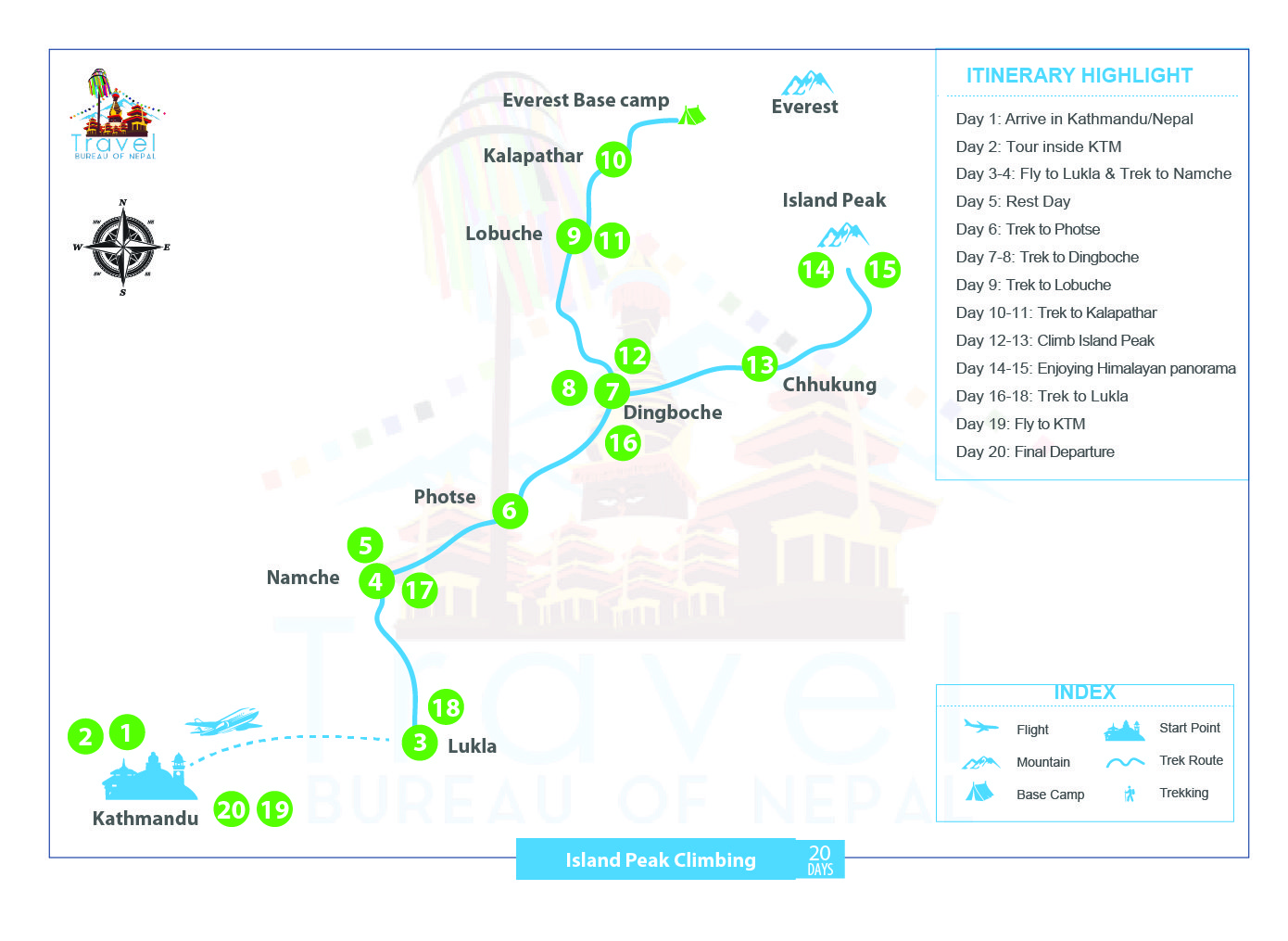
FAQs
-
What permits are required for this peak?
As for this climbing trip, you would need a special climbing permit along with Everest and Sagarmatha National Park permits and a TIMS card (trekking information management system). We obtains all of these permits and travel documents for you.
-
What is the average walking time per day?
Usually not more than 6–8 hours, excluding lunch. As for the time to the Island Peak summit and back to base camp, it solely depends on your pace. We allow you enough time to set your own pace for acclimatization and to make every day more entertaining, yet the walking time varies depending on you and your group. We usually start early so that you can reach the destination on time, leaving you enough time to explore and enjoy the serenity of the place.
-
Do I need travel insurance for an emergency to join the climb ?
We strongly suggest you have an all-inclusive travel insurance policy covering all the aspects of your adventure, though we assure you that there would be hardly any evacuations or any health catastrophes as your leader is medically trained and has ample knowledge to deal with any life-threatening situation. But it's always wise to have insurance as your backup just in case.
-
How difficult is the Island Peak expedition? Can anyone join?
Though the Island peak expedition is not technically challenging it is unquestionably physically demanding which is graded as Alpine PD+. Island peak is quite popular for its suitability for all beginner and experienced trekkers who desire to experience climbing. However, anyone with sound fitness can join but the altitude and acclimatization process is the major issue than the level of fitness. Travel bureau Nepal has an itinerary so designed to provide ample time for acclimatization strategy with slow pacing and multiple side excursions

